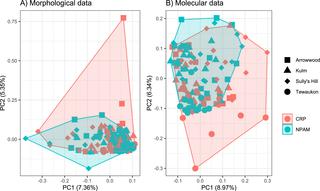Our official English website, www.x-mol.net, welcomes your
feedback! (Note: you will need to create a separate account there.)
Molecular sequencing and morphological identification reveal similar patterns in native bee communities across public and private grasslands of eastern North Dakota.
PLOS ONE ( IF 2.9 ) Pub Date : 2020-01-23 , DOI: 10.1371/journal.pone.0227918 Brian Darby 1 , Russ Bryant 2, 3 , Abby Keller 1 , Madison Jochim 1 , Josephine Moe 1 , Zoe Schreiner 1 , Carrie Pratt 1 , Ned H Euliss 2 , Mia Park 1, 4 , Rebecca Simmons 1 , Clint Otto 2
PLOS ONE ( IF 2.9 ) Pub Date : 2020-01-23 , DOI: 10.1371/journal.pone.0227918 Brian Darby 1 , Russ Bryant 2, 3 , Abby Keller 1 , Madison Jochim 1 , Josephine Moe 1 , Zoe Schreiner 1 , Carrie Pratt 1 , Ned H Euliss 2 , Mia Park 1, 4 , Rebecca Simmons 1 , Clint Otto 2
Affiliation

|
Bees play a key role in the functioning of human-modified and natural ecosystems by pollinating agricultural crops and wild plant communities. Global pollinator conservation efforts need large-scale and long-term monitoring to detect changes in species' demographic patterns and shifts in bee community structure. The objective of this project was to test a molecular sequencing pipeline that would utilize a commonly used locus, produce accurate and precise identifications consistent with morphological identifications, and generate data that are both qualitative and quantitative. We applied this amplicon sequencing pipeline to native bee communities sampled across Conservation Reserve Program (CRP) lands and native grasslands in eastern North Dakota. We found the 28S LSU locus to be more capable of discriminating between species than the 18S SSU rRNA locus, and in some cases even resolved instances of cryptic species or morphologically ambiguous species complexes. Overall, we found the amplicon sequencing method to be a qualitatively accurate representation of the sampled bee community richness and species identity, especially when a well-curated database of known 28S LSU sequences is available. Both morphological identification and molecular sequencing revealed similar patterns in native bee community structure across CRP lands and native prairie. Additionally, a genetic algorithm approach to compute taxon-specific correction factors using a small subset of the most concordant samples demonstrated that a high level of quantitative accuracy could be possible if the specimens are fresh and processed soon after collection. Here we provide a first step to a molecular pipeline for identifying insect pollinator communities. This tool should prove useful for future national monitoring efforts as use of molecular tools becomes more affordable and as numbers of 28S LSU sequences for pollinator species increase in publicly-available databases.
中文翻译:

分子测序和形态学鉴定揭示了北达科他州东部公共和私人草原上本地蜂群落的相似模式。
蜜蜂通过给农作物和野生植物授粉,在人类修饰的自然生态系统的功能中发挥关键作用。全球传粉媒介的保护工作需要大规模和长期的监测,以发现物种的人口统计学特征的变化和蜜蜂群落结构的变化。该项目的目的是测试一种分子测序管线,该管线将利用常用的基因座,产生与形态学鉴定相一致的准确和精确的鉴定,并生成定性和定量的数据。我们将此扩增子测序流程应用于在北达科他州东部的自然保护区(CRP)土地和原生草地上采样的原生蜂群落。我们发现,与18S SSU rRNA基因座相比,28S LSU基因座更能区分物种,在某些情况下,甚至可以解析隐性物种或形态上模糊的物种复合体。总的来说,我们发现扩增子测序方法可以从质量上准确地代表所采样的蜜蜂群落的丰富度和种类,特别是当已知28S LSU序列的精心整理的数据库可用时。形态学鉴定和分子测序都揭示了跨CRP土地和天然草原的天然蜂群落结构的相似模式。另外,遗传算法使用最一致的样本的一小部分来计算分类群特定的校正因子,表明如果样本新鲜并在收集后立即进行处理,则可能具有较高的定量准确性。在这里,我们为识别昆虫授粉媒介群落的分子管线提供了第一步。随着分子工具的使用变得越来越负担得起以及授粉物种的28S LSU序列数量在公众可获得的数据库中增加,该工具应被证明对未来的国家监测工作很有用。
更新日期:2020-01-24
中文翻译:

分子测序和形态学鉴定揭示了北达科他州东部公共和私人草原上本地蜂群落的相似模式。
蜜蜂通过给农作物和野生植物授粉,在人类修饰的自然生态系统的功能中发挥关键作用。全球传粉媒介的保护工作需要大规模和长期的监测,以发现物种的人口统计学特征的变化和蜜蜂群落结构的变化。该项目的目的是测试一种分子测序管线,该管线将利用常用的基因座,产生与形态学鉴定相一致的准确和精确的鉴定,并生成定性和定量的数据。我们将此扩增子测序流程应用于在北达科他州东部的自然保护区(CRP)土地和原生草地上采样的原生蜂群落。我们发现,与18S SSU rRNA基因座相比,28S LSU基因座更能区分物种,在某些情况下,甚至可以解析隐性物种或形态上模糊的物种复合体。总的来说,我们发现扩增子测序方法可以从质量上准确地代表所采样的蜜蜂群落的丰富度和种类,特别是当已知28S LSU序列的精心整理的数据库可用时。形态学鉴定和分子测序都揭示了跨CRP土地和天然草原的天然蜂群落结构的相似模式。另外,遗传算法使用最一致的样本的一小部分来计算分类群特定的校正因子,表明如果样本新鲜并在收集后立即进行处理,则可能具有较高的定量准确性。在这里,我们为识别昆虫授粉媒介群落的分子管线提供了第一步。随着分子工具的使用变得越来越负担得起以及授粉物种的28S LSU序列数量在公众可获得的数据库中增加,该工具应被证明对未来的国家监测工作很有用。











































 京公网安备 11010802027423号
京公网安备 11010802027423号